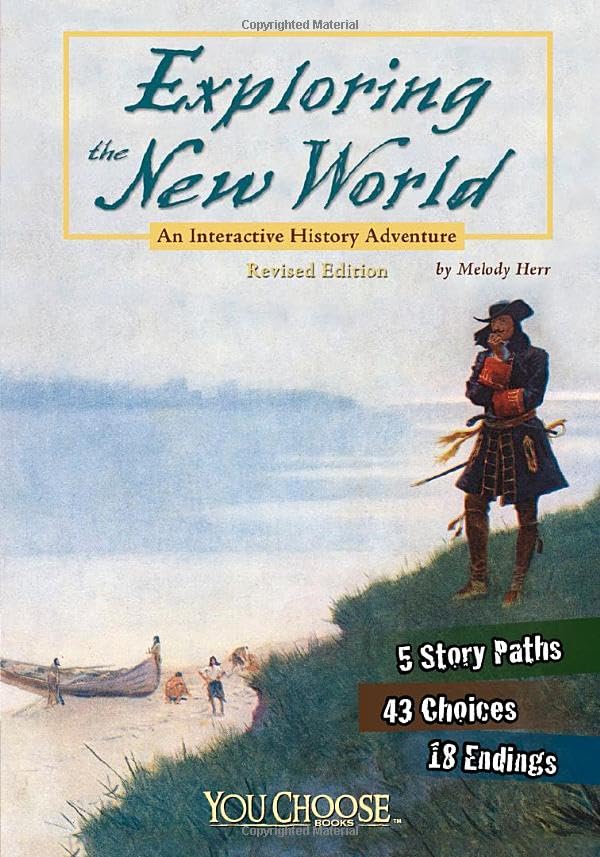Fur Traders, Pirates, and Colonial Explorers Resources and Supplements
Dates covered: 1659-1716
Contains affiliate links
If you appreciate these resources, please consider supporting me on Patreon to enable me to continue to provide more free resources.
Sonlight Selection:
- The Landmark History of the American People, Volume I
- American History: A Visual Encyclopedia
- The Beginner’s American History
American History Easy Make and Learn Books:
- Interactive 3D Maps: American History
- Piracy on the High Seas, Page 42
Arts and Crafts:
Books (All Ages):

It is 1792 and unbeknownst to a group of voyageurs traveling from Montreal to Grand Portage, an intrepid squirrel, Jean Pierre Petit Le Rouge, sneaks onto their canoe. Le Rouge is soon discovered because he can’t contain his excitement–mon dieu he is so enthusiastic. The smells! The vistas! The comradery!
The voyageurs are not particularly happy to have him, especially because Le Rouge rides, but he does not paddle. He eats, but he does not cook. He doesn’t even carry anything on portages–sometimes it is he who has to be carried. He also has a terrible singing voice. What kind of voyageur is that?
When they finally arrive at the trading post Le Rouge is in for a terrible shock–the voyageurs have traveled all those miles to collect beaver pelts. With the help of Monique, a smart and sweet flying squirrel, Le Rouge organizes his fur-bearing friends of the forest to ambush the men and try and convince them to quit being voyagers. Level 4.7. Younger to Middle students.

Birchbark Brigade: A Fur Trade History A history of the North American fur trade, based on primary sources. The North American fur trade, set in motion by the discovery of the New World in the fifteenth century, was this continent’s biggest business for over three hundred years. Furs harvested by Ojibwa natives in the north woods ended up on the sleeves and hems of French princesses and Chinese emperors. Felt hats on the heads of every European businessman began as beaver pelts carried in birchbark canoes to trading posts dotting the wilderness. Iron tools, woolen blankets, and calico cloth manufactured in England found their way to wigwams along the remote rivers of North America. The fur trade influenced every aspect of lifefrom how Europeans related to the Indians, how and where settlements were built, to how our nation formed. Drawing on primary sources, including the diaries of Ojibwa, American, and French traders of the period, this Society of School Librarians International Honor Book gives readers a glimpse of a little-known story from our past. Older students. Level 8.4.
1659 Radisson and des Groseilliers
Radisson and des Groseilliers: Fur Traders of the North nonfiction book explains how their trade routes helped open up the mid-west of the United States and Canada and how their discoveries led to the creation of the Hudson’s Bay Company. Level 7.0 Canada. Quebec. Wisconsin.
1673 Marquette and Jolliet (AKA Joliet)
Explore with Marquette and Jolliet magazine-style account of their adventure level 6.0
Jacques Marquette and Louis Jolliet easy to digest short nonfiction, level 5.2
The Story of Marquette and Jolliet Cornerstones of Freedom series. nonfiction easy to read biography level 4.9
1678 Rene-Robert Cavelier, Sieur de La Salle
Despite All Obstacles: La Salle and the Conquest of the Mississippi To say that Rene-Robert Cavelier, Sieur de La Salle was determined is like saying the sun is warm. La Salle made his way from Eastern Canada to the Great Lakes. Then he traveled by canoe down the Mississippi to the Gulf of Mexico. This vast territory was dense unexplored wilderness, controlled by the fierce and powerful Iroquois. To make the merely daunting nearly impossible, La Salle was on his own. His King, Louis X1V, would provide neither protection, men nor money. Through one setback after another, La Salle kept on going. His men deserted him; he walked a thousand miles, in the middle of the brutal Canadian winter, back to Montreal and organized a new expedition. The Iroquois threatened; he brought together rival tribes, and speaking in their own language, united them into an alliance against the Iroquois. La Salle’s ship sunk with a fortune in furs meant to finance his expedition. Again, he walked back to Montreal and found new financial support. Middle to Older students.

Exploring the New World: An Interactive History Adventure A Choose-your-own-adventure style book, choose to follow Columbus, Coronado, and La Salle. The reader’s choices reveal the historical details from the perspective of a sailor or a Taino Indian during Columbus’ voyage in 1492, a Spanish adventurer or a Zuni Indian during Coronado’s 1540 expedition, and a member of Sieur de La Salle’s expedition down the Mississippi River in 1682. With 5 story paths, 43 choices, and 18 endings, each time you read, you can follow a new story. Younger to Middle students.

Journey to La Salle’s Settlement Two siblings, along with their friend Jackie, find themselves in a wooden canoe off the seventeenth-century Texas coast—with a gale approaching and nothing to get them home but a magic ring and a list of riddles. No sooner does their rescuer, Sébastien, haul the trio aboard ship than they are pressed into service on the doomed French bark La Belle. Level 4.3. Mature Middle and Older students (contains time-travel, also contains a lot of danger and suspense, attacks, killing, etc.). Texas.

La Salle and the Mississippi River A biography of the seventeenth-century French explorer who was the first European to travel the entire length of the Mississippi River, claiming for France not only that river but also all the land whose waters fed into it. Level 4.8. Younger to Middle students.
Sieur de La Salle nonfiction. Error on the Amazon page; the author is Mary Englor. Level 4.0
Where is Niagara Falls?, from the Who Was? Series, placed here because Niagara Falls was first discovered by white man during this year. Lexile 780. New York.
1692
Madeleine Takes Command Madeleine Verchère’s story is based on a true account of colonial French Canada of the 1690s. Madeleine’s family’s fort must keep a continual guard from Iroquois attack. 14-year-old Madeleine is left alone with two younger brothers, some women and children, and a few others when the Indians attack. Through her bravery, she is able to defend the fort for days until help arrives. Quebec, Canada. Middle to Older students.
1695
Captain Kidd: Seventeenth Century Pirate of the Indian Ocean and African Coast In this book, children will learn how the son of a minister became one of the most wanted pirates of all time. Captain Kidd started out capturing pirates, then took over the Quedagh Merchant and her fortune, renaming the ship the Adventure Prize. Kidd never thought of himself as a pirate, but the British government did and set out to make an example of him. All of Kidd’s adventures are here, as well as some thoughts on the whereabouts of his still-missing treasure. Level 4.6. Younger to Middle students. New York.
Captain Kidd’s Crew Experiments with Sinking and Floating Aye, aye, matey! Captain Kidd here, and I’m on an adventure on the high seas. I’ve always wondered why me boat floats but me treasure sinks. Follow me crew to find out all about sinking and floating! Picture Book. Level 3.3. Younger students.
1700
Hostage on the Nighthawk Dave and Neta Jackson series, occurs in the time period of William Penn and Captain Kidd, although neither really appear. Historical fiction. While trying to sail back to England, a mother and two children wind up on a pirate’s boat and try to escape. Grade level 4-6. Pennsylvania. Middle to older students.
1701
Antoine de la Mothe Cadillac: French settlements at Detroit and Louisiana nonfiction. Level 7.1. Michigan. Louisiana.
1707
The Courage of Sarah Noble In 1707, young Sarah Noble and her father traveled through the wilderness to build a new home for their family. “Keep up your courage, Sarah Noble,” her mother had said, but Sarah found that it was not always easy to feel brave inside. The dark woods were full of animals and Indians, too, and Sarah was only eight! Connecticut. Younger to Middle students.
1716
Blackbeard: Eighteenth-Century Pirate of the Spanish Main and Carolina Coast Discusses the life of Edward Teach, better known as Blackbeard, who terrorized the Virginia and North Carolina coasts before he was killed in 1718. Nonfiction.Level 4.8. North Carolina. South Carolina. Virginia.

Blackbeard’s Sword: The Pirate King of the Carolinas The Royal Navy recruits fisherman Jacob Webster to help them catch the notorious pirate Blackbeard, but Jacob wants to help save his hero’s life instead. Younger to Middle students.
Trouble at Fort La Pointe (An American Girl History Mysteries) A young half-Ojibwe, half-French girl lives at a French Trading Post with her family, where trouble arises. Reader-syle historical fiction, level 4.9. Wisconsin.
Who Was Blackbeard? Part of the Who Was Series, a look at the life of Edward Teach, the famous pirate. Level 6.2. North and South Carolina, Virginia. England.
Coloring Pages/Drawing:
- Radisson and des Groseilliers
- Marquette and Jolliet
- Marquette Coloring Page
- Jolliet Coloring Page
- La Salle Coloring Page
- Pirate Coloring Pages
Lapbooks/Notebooking Pages/Unit Studies/Activity Pages/Paper Dolls/Games:
Museums/Field Trips (including virtual):
- Snake River Fur Post, Minnesota
- Grand Portage National Monument, Minnesota
- Museum of the Fur Trade, Nebraska
- Canadian Museum of History, Quebec
- Calhoun County Museum, Texas
- Niagara Falls
- Pirate and Treasure Museum, Florida
- Blackbeard Museum, North Carolina
Recipes:
Songs:
- Great Big Sea – Captain Kidd
- Aviron: Song of the Voyageurs
- Voyageur Song HQ
- “Let’s Go Exploring” – Marquette and Joliet Song
- Rene – Robert Cavelier Sieur de La Salle
- Great Big Sea – Captain Kidd
- Rene-Robert Cavalier, Sieur de La Salle
- The Blackbeard Song | Putrid Pirates | Horrible Histories (Horrible Histories warning)
- Theron Statler – Blackbeard
Videos and Movies
- There is a series called Quest for the Bay, a reality-style show (not competitive, and cleaner than most) where they attempted to recreate the journey made by fur traders of the Hudson’s Bay Company during the 1840s by traveling from Winnipeg to Hudson Bay. They try to keep as true to history as possible, using old tools and carrying only food they would have used back then.
- America’s Treasures: Fur Trade (Full Episode)
- Hudson’s Bay Company History
- Louis Jolliet & Jacques Marquette | PBS World Explorers
- René-Robert Cavelier de La Salle | PBS World Explorers
- The Story of Captain Kidd in 90 Seconds | The Children’s Museum of Indianapolis
- Mar 5 French explorer Antoine Cadillac
- Blackbeard: The True Story

















